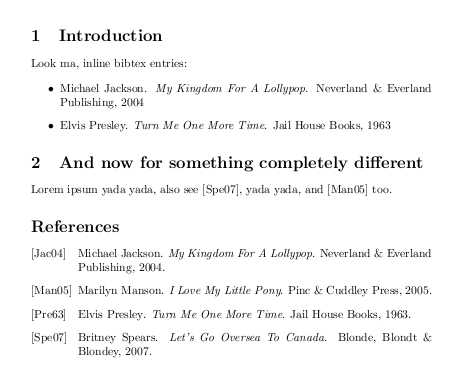In the introduction chapter of my PhD dissertation, I had to make a listing of my publications. The obvious brain dead way to achieve this is just typing everything manually in a list. But this feels just so wrong when you're already using BibTeX for managing references and bibliographical stuff. However, the traditional usage of BibTeX in LaTeX is to generate a full list of all references and put this in a dedicated section or chapter.
With the bibentry package (which is part of the natlib package actually) it is possible to put bibliographic entries anywhere in the text. As far as I know and experienced, the bibentry package is included in a default LaTeX setup, so you don't have to install something, just enable it in your document.
Getting it work as desired can take some trial and error, so I thought it may be a good idea to feed "them search engines" with a working example.
Here is a simple proof of concept example LaTeX document test_bibentry.tex:
\documentclass{article}
\usepackage{bibentry}
\nobibliography*
\begin{document}
\section{Introduction}
Look ma, inline bibtex entries:
\begin{itemize}
\item \bibentry{michael}
\item \bibentry{elvis}
\end{itemize}
\section{And now for something completely different}
Lorem ipsum yada yada,
also see \cite{britney},
yada yada, and \cite{marilyn} too.
\bibliographystyle{alpha}
\bibliography{test_bibentry.bib}
\end{document}
The stuff that's important here:
- \usepackage{bibentry}: duh.
- \nobibliography*: tells bibentry to (re)use the bibliographic data from the standard BibTeX setup by \bibliography{test_bibentry.bib}.
- \bibentry{foo}: an inline bibliographic entry will be put here.
Here is the accompanying BibTeX file test_bibentry.bib:
@Book{michael,
author = "Michael Jackson",
title = "My Kingdom For A Lollypop",
publisher = "Neverland \& Everland Publishing",
year = 2004
}
@Book{elvis,
author = "Elvis Presley",
title = "Turn Me One More Time",
publisher = "Jail House Books",
year = 1963
}
@Book{britney,
author = "Britney Spears",
title = "Let's Go Oversea To Canada",
publisher = "Blonde, Blondt \& Blondey",
year = 2007
}
@Book{marilyn,
author = "Marilyn Manson",
title = "I Love My Little Pony",
publisher = "Pinc \& Cuddley Press",
year = 2005
}
And here is what it looks like in the end:

Note the inline entries in the introduction section, the standard \cite{} references in the second section and how all references show up in the final bibliographic listing. Just how I wanted it in my PhD dissertation. With slightly different content of course.